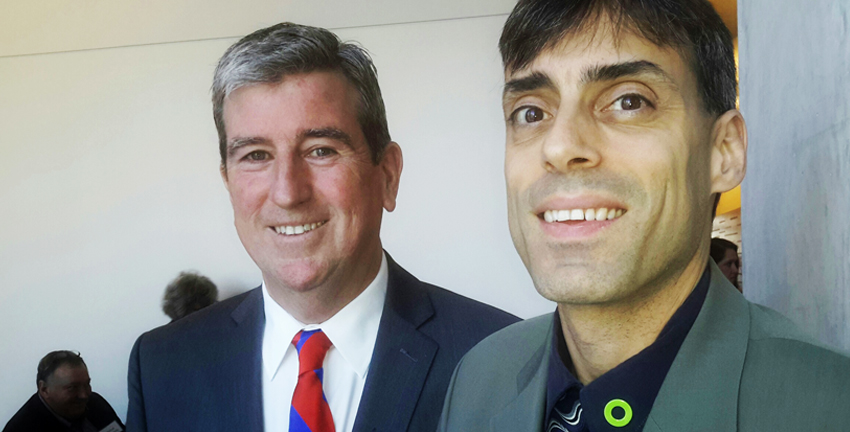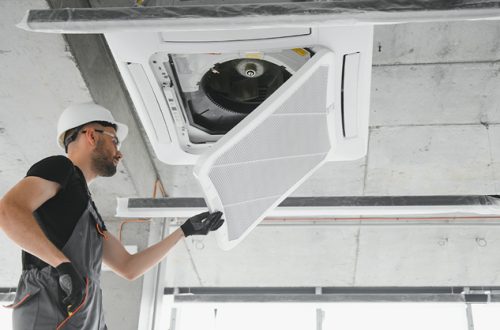
Yannick Trottier is a professional engineer with a degree in aerospace engineering from MIT. He is also a committed climate change advocate.
As an undergraduate, Trottier was first exposed to climate change while working on the original Odyssey autonomous underwater vehicle – a submarine that takes conductivity-temperature-salinity measurements – at MIT’s Autonomous Underwater Vehicle Laboratory. In the spring of 1994, the lab deployed the Odyssey from an ice camp in the Beaufort Sea to study Arctic sea ice mechanics. Late one night, the team woke up to the loud screeching sound of a huge crack that had ripped across the camp’s runway. Luckily, they were safely evacuated by helicopters. Just two weeks later, this ice shelf which had been stable for thousands of years completely collapsed. Later that year the Intergovernmental Panel on Climate Change (IPCC) released a draft of their second assessment report which stated that the melting of the Arctic sea ice was caused by climate change.
“At that point I thought, ‘Okay well, we have a problem, governments are going to take this seriously now that the science is coming out. Governments will fix this like how they fixed other major global challenges like acid rain and the ozone hole.’ I didn’t think this needed to be my problem. I thought I could go on with my career and people who specialized in climate science and policy would figure out the solution,” Trottier said.
Following this experience, he became increasingly concerned over the lack of action by governments to address climate change, and when the 2009 United Nations Climate Change conference, commonly known as the Copenhagen Summit, failed to deliver a global agreement, Trottier fell into a period of “climate depression” – the despair and disempowerment induced by society’s lack of action around climate change issues.
“I had lost all hope – but that’s when I decided this was too important of a problem to give up without a fight.”
Trottier has since become a tireless advocate for policies and infrastructure that would transition the world away from fossil fuels and toward cleaner, renewable sources of energy. He is chair of the Toronto chapter of the Citizen’s Climate Lobby (CCL) – an international organization that lobbies politicians for action on climate change. Trottier is specifically interested in lobbying for the adoption of a carbon fee and dividend policy, which places a progressive fee on fossil fuels and returns the revenue generated to households as a way to encourage transitioning to a sustainable future. In Canada, the CCL has started to see the fee and dividend policy enter into political discourse – it was even adopted federally and provincially by the Green Party.
Trottier is also a member of the Climate Reality Project, where he was personally trained by former US Vice President Al Gore to raise awareness about the science and impact of climate change. Trottier uses this as an opportunity to motivate fellow engineers to become active participants in addressing the climate crisis, and to make them better aware of the solutions that engineers can help enact.
For Trottier, it is especially important for engineers to be aware of climate change and to be a part of the solution. “It is going to be up to engineers to move the world forward. It is the scientists who identify the problem and the economists who figure out how to pay for it, but it will be engineers who figure out how to get energy without fire.”
One solution that he advocates for is a coast-to-coast ultra-high voltage direct current super grid. “With the exception of hydro-electric reservoirs, all the ways we can produce electricity without fossil fuels share a common flaw in that they are inflexible. Whether you use nuclear, wind or solar power, electricity is not necessarily going to be available when you need it. We need a clean way to store energy from the time that generation is available to when it is not. One of the best ways to do this is with hydro-electric reservoirs.
In Canada, we can only build hydro-electric reservoirs out west and in Quebec where we have mountains. In order for the rest of Canada to have access to large amounts of clean energy, we need to connect to those reservoirs at ultra-high voltage levels,” Trottier said.
“The solutions are more than just solar and wind panels – it’s also about local thermal storage. Engineers get excited about this new type of technology and this is good. It’s the kind of conversation that we need to start having.”
Trottier strongly believes that global warming is a central ethical issue for engineers and he hopes to see them embrace climate responsibility in their professional practice. “Climate change is the greatest threat to public safety that the world has ever seen. If this doesn’t trigger our code of ethics, then what does?”
When asked what he believes to be his biggest accomplishment as a climate change advocate, Trottier modestly responds, “it’s hard for me to think of that in a background where emissions and temperatures keep going up, where climate catastrophes are getting bigger and more frequent, and when every scientific review says it’s worse than we thought. But what keeps me going is when someone who used to be a skeptic sees me speak and thanks me for turning them into a believer.”
Yannick Trottier is a climate change advocate and professional engineer with an MIT degree in aerospace engineering. He is Chair of the Citizen’s Climate Lobby (CCL) – Toronto Chapter and a trained Climate Reality Project presenter who specializes in presentations for engineers. If you would like to host a Climate Reality presentation in your organization or community, please visit www.climatereality.ca.





Comment (1)
Je suis français. Je m’intéresse aux problèmes engendrés par le changement climatique. Ce que les gens de notre pays n’ont pas conscience. J’aurai voulu, publier ce qui est rapporté, sur cette page. Mais je n’y parviens pas. En temps que technicien gazier, j’essaie de faire adopter le gaz comme carburant pour les bus de ville et pour les poids lourds, grâce à des informations que l’on me fait parvenir. Déjà des stations d’avitaillement ont été crées, en France et en Europe. Mais, certains ont du mal, à être convaincu de la chose. Merci! de votre participation.
Leave a Comment